Did you know that 54.31% of search queries contain 3 or more words? These are called long tail keywords, and optimizing your content on them can help increase organic traffic, improve rankings on Google and boost conversions.
In this post, we’ll show you how to find long tail keywords and use them to increase organic traffic, as well as boost rankings and conversions. We’ll also explain what long tail keywords are and why they are important for SEO.
If you want to jump straight to a section, you can use these quick links:
In This Article
What Are Long Tail Keywords?
Long tail keywords are longer phrases people enter in search engines when they’re looking for something specific.
Often, they’re 3 or more words in comparison with short tail keywords that are usually 1 to 2 words. And they can help increase organic traffic, dominate search engine rankings, and boost conversions.
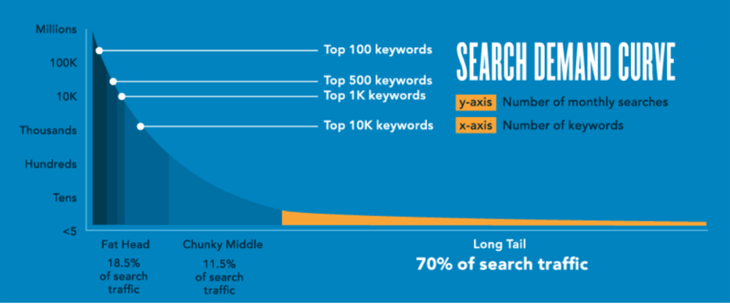
In fact, long tail keywords make up for 70% of search traffic. So if you want to get more organic traffic and improve your SEO rankings, you should definitely use long tail keywords in your content.
Here’s an infographic from OptinMonster illustrating long tail keywords and how they offer a higher conversion rate than short tail keywords and less competition.
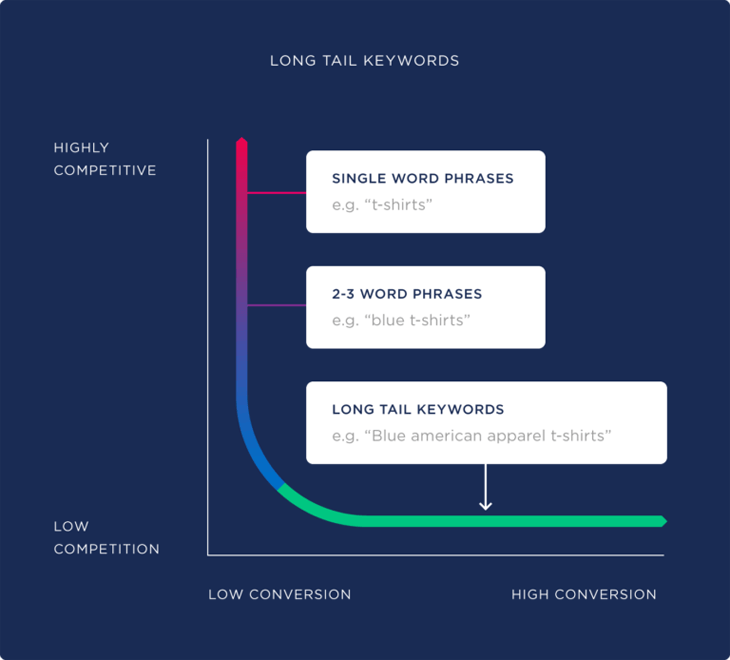
As you can see, the longer the phrase, the more specific it is, and the fewer search results there’ll be when people type it in.
The competition is less and the conversion rate is higher. This makes up for great ranking opportunities!
Let’s give you an example of a long vs short tail keyword…
Long Tail Keyword Example
A person is about to purchase running shoes and is browsing Google. An example of a long tail keyword search would be: “buy running shoes for flat feet”. On the other hand, a short tail keyword search would be: “buy shoes”.
Did you see the difference?
Long tail search terms are not only longer, but have a very precise search intent, which is one of the most important rankings factors on Google. It tries to understand the intent behind every search query and matches it with the best results.
So using long tail keywords in your content will help you dominate the search results for less competitive search terms with a high search intent.
On the other hand, short tail keywords are broader and provide information to users when they’re in the early stages of purchasing a product or searching for information.
That said, let’s take a look at why long tail keywords are important for SEO?
Why Are Long Tail Keywords Important for SEO?
Long tail keywords are important for SEO since they can help increase organic traffic, dominate search engine rankings, and boost conversions. They can also help less established websites to rank in search engines and get ahead of their competition.
Here’s a detailed look at why you should be using long tail keywords…
1. Long Tail Keywords Are Easier to Rank for on Google
Given the vastness of the internet and high competition on common keywords, long tail keywords are easier to rank for on Google.
That’s because they are so specific that not many businesses would be competing to grab the top spot on the search results of Google. They generally have a lower search volume, which makes them less targeted by the “big players” online.
For example, if you use a keyword research tool like Ahrefs, you can see that the search volume for the long tail keyword phrase: “running shoes for flat feet” has an average of 4.0K monthly searches. It also has low keyword difficulty, meaning how hard it is to rank in the top 10 search results for that keyword.

On the other hand, the short tail keyword: “running shoes” has an average of 120K monthly searches and keyword difficulty of 68, which means it has more competition and is harder to rank for on Google.
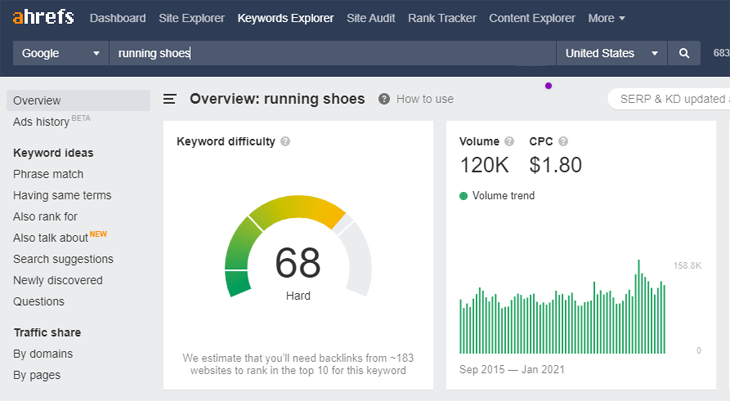
That’s why a better strategy is to target long search phrases with less competition and a more specific search intent.
Another reason for using long tail keywords is that they can help you generate sales and grow your business, as we’ll explain next.
2. Long Tail Keywords Have a High Conversion Rate

When a user is in the final stages of the buying cycle, it’s more likely that they’ll use long tail keywords to find exactly what they’re looking for and then make a purchase.
In fact, long tail keywords have 2.5X higher chance of converting than short tail keywords. This means that long tail keywords will help boost CTR (Click-Through-Rate) in search results.
So, if you’re looking to grow your business, you should definitely target long tail keywords as they’ll boost your conversion rate.
Now, let’s take a look at how to find long tail keywords next.
How to Find Long Tail Keywords?
Here are 3 quick and easy ways to find long tail keywords:
1. Use AIOSEO’s Get Additional Keyphrases by Semrush Tool
An easy way to find long tail keywords is by using the best SEO plugin for WordPress, All in One SEO (AIOSEO) and its get additional keyphrases by Semrush tool.
To get started finding these high-converting search terms, you first need to install and activate AIOSEO. If you’ve never installed a plugin before, you can check out WPBeginner’s step by step guide on how to install a WordPress plugin.
Then, you need to scroll down in the post or page you’re editing to the AIOSEO Settings, and click on the General tab.
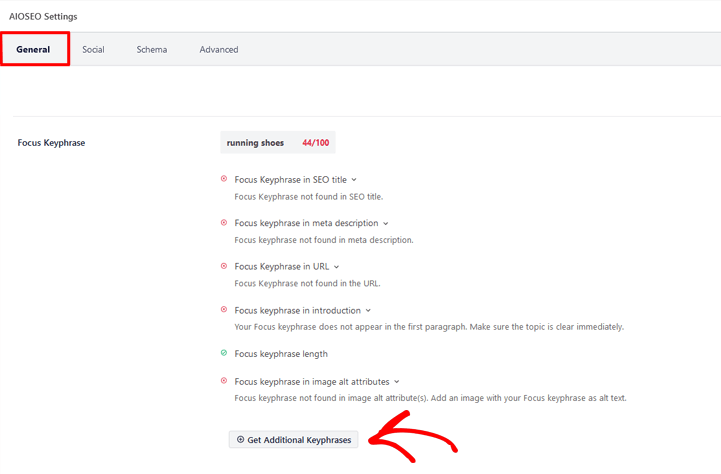
After you’ve first added your Focus Keyphrase, you simply click on the Get Additional Keyphrases button.
This will open a new window with Additional Keyphrases by Semrush. And if you don’t already have a Semrush account, it will ask you to create one and connect AIOSEO. It’s super easy and straightforward!

Anyhow, here you can find examples of additional keyphrases and even see their search volume and trend straight from the screen. Here you can see that the search term: “nike running shoes for women” is a highly targeted long tail keyword that would be a good option to add to your content.
It still has good search volume and will be easier to rank for on Google than the short tail keyword: “running shoes”.
And once you’ve decided which keyphrase to use, you simply click on the Add Keyphrase button, and it gets added to your content.

As simple as that!
Best of all, AIOSEO even gives you an SEO analysis of how well you’ve optimized your long tail keyword in your content.
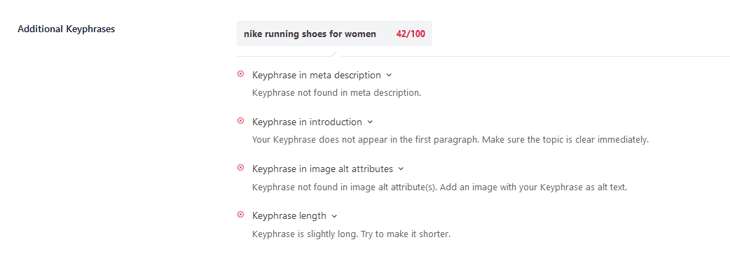
As you can see, we haven’t optimized our content on this long tail keyword, but you get the point. The red bullet points are recommendations on what you need to improve to maximize rankings in search engines and drive more organic traffic to your site.
These tips are super useful if you want to boost your SEO and get ahead of your competition!
2. Look at Your Google Search Console Report
Another option is to check your Google Search Console report for the long tail keywords that are already bringing traffic to your site. This will help you find similar search terms that you can target or you can use the data to improve your existing content.
To easily do this, you can use the best WordPress Analytics plugin, MonsterInsights. It lets you view your Google Search Console reports directly inside your WordPress dashboard.
And when using the Search Console Report, you can see the top keywords that get the most clicks, impressions, CTR, and their average position.

As you can see from the above screenshot, almost all the top keywords are long tail keywords. These are the search terms that bring the majority of organic traffic and improve the CTR of your website.
The next step is to improve your existing content for these long tail keywords or find new similar ones. You can do that by using Google autocomplete, people also ask, or related searches.
3. Use Google Autocomplete, People Also Ask, or Related Searches
Another simple way of finding long tail keywords is by entering a short tail keyword or your main keyword in Google (don’t hit enter) and then look at the autocomplete suggestions.
These are more specific search queries that people look for and are related to your overall topic.
For example, if you’d type in “keto diet” in Google, you’ll see these autocomplete suggestions:

This way, you can get many long tail keyword ideas to optimize your content on.
You can also look at the People also ask section. For instance, when you enter a search term on Google, you’ll notice a set of questions under a box called People also ask.
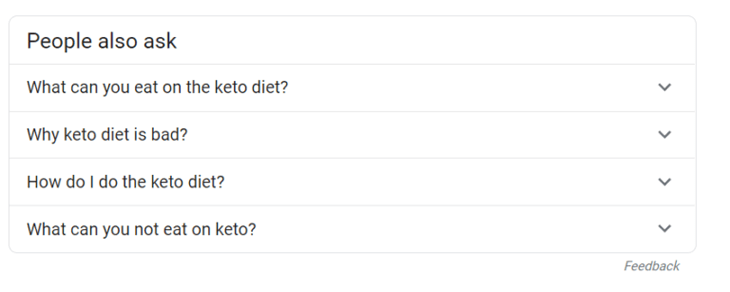
Using Google, it’s easy to get long tail keywords ideas.
And there’s even one more way…
If you scroll down to the bottom of the page, you’ll find more suggestions by Google in the Related Searches section.
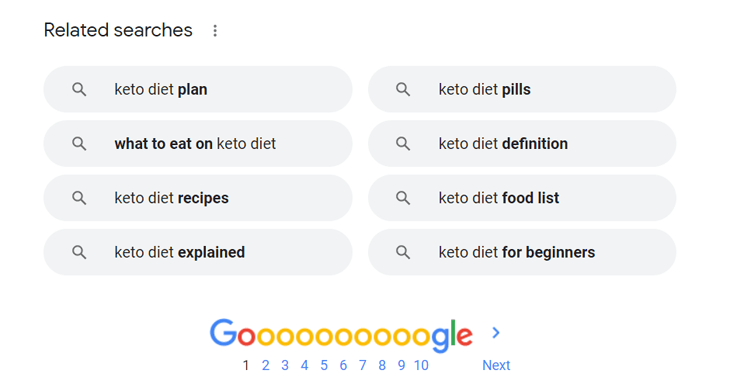
Now you have many good search phrases to choose from.
Once you’ve checked that your long tail keywords have enough search volume, the last step is to create content and optimize it on your keywords so that you can increase organic traffic, SEO rankings, and conversions.
And like you already know, AIOSEO helps you with that!
With AIOSEO, you get access to the following powerful SEO features and more:
- Video and News Sitemaps — automatically generate a video sitemap or news sitemap and notify Google of all your new video content and news updates.
- Analyze Your Competitors’ SEO — analyze your competitors’ SEO and find out what keywords they’re using to get ahead and gain an edge.
- Rich Snippets Schema — add schema markup to your pages and get more clicks and traffic with Google rich snippets.
- WooCommerce SEO — easily optimize your product title and meta descriptions and boost rankings for your product pages.
And there you have it!
We hope this helped you understand how to find long tail keywords and increase organic traffic. As well as improve your rankings in search engines and dominate the search results. Use these quick and simple tips, and you’ll skyrocket your traffic and conversions on Google before you know it.
Also, if you have a local business or are offering services locally, you should check out our local SEO checklist to learn how to rank in local search and on Google Maps.
Wait! Don’t leave without your special gift….
…get going super fast with our 30 SEO hacks guaranteed to grow your traffic. These quick and simple hacks will help you optimize your website like a pro in no time.
Not using AlOSEO yet? Get started today!
Disclosure: Our content is reader-supported. This means if you click on some of our links, then we may earn a commission. We only recommend products that we believe will add value to our readers.

